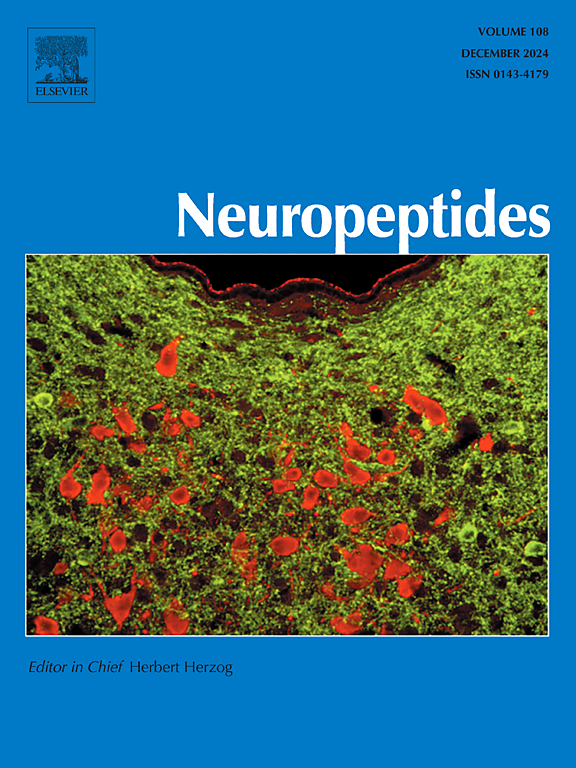Ginsenoside Rg1 improves autophagy dysfunction to ameliorate Alzheimer's disease via targeting FGR proto-oncogene
IF 2.7
3区 医学
Q3 ENDOCRINOLOGY & METABOLISM
引用次数: 0
Abstract
Alzheimer's disease (AD) is a neurodegeneration driven by beta-amyloid (Aβ) deposits in the brain involving autophagy dysfunction. Ginsenoside Rg1, a pharmacologically active compound found in ginseng, has possible therapeutic effects for AD. This study discovered that FGR proto-oncogene (FGR) was a therapeutic target of Rg1 in AD and it was possibly involved in autophagy. C57BL/6 J mice were injected with 5 μL (1 μg/mL) Aβ1–42 in the right lateral ventricle to establish an AD model. AD mouse hippocampus had high FGR expression. Intragastrically administered Rg1 (40 mg/kg) decreased FGR protein levels in AD mice's hippocampus and improved memory function in AD mice. Both sides of the mice hippocampal fissure were administered with 2 μL lentiviral particles (1 × 107 TU) containing FGR overexpression plasmids. FGR overexpression rendered Rg1 ineffectual in restoring memory function and reducing hippocampal neuron damage. We injected 2 μL lentiviral particles (1 × 107 TU) containing short hairpin RNA plasmids targeting FGR to the mice hippocampal fissures. FGR knockdown improved spatial memory function of AD mice, reduced hippocampal neuron apoptosis, and prevented Aβ accumulation. HT22 cells were transfected with small interfering RNA targeting FGR. FGR knockdown increased the viability of Aβ1–42 treated HT22 cells. BACE1 and LC3II/I protein levels were decreased and p62 and SIRT1 were increased in AD mice and cells with FGR knockdown. LC3 was down-regulated after inhibiting FGR expression in Aβ1–42 treated hippocampal neurons. In conclusion, Rg1 exerts anti-AD functions by targeting FGR and downregulating its expression.
人参皂苷Rg1通过靶向FGR原癌基因改善自噬功能障碍,改善阿尔茨海默病
阿尔茨海默病(AD)是一种由大脑中β -淀粉样蛋白(a β)沉积引起的神经变性,涉及自噬功能障碍。人参皂苷Rg1是人参中发现的一种药理活性化合物,可能对阿尔茨海默病有治疗作用。本研究发现FGR原癌基因(FGR)是Rg1在AD中的治疗靶点,并可能参与自噬。将5 μL (1 μg/mL) Aβ1-42注入C57BL/6 J小鼠右侧脑室,建立AD模型。AD小鼠海马FGR高表达。灌胃Rg1 (40 mg/kg)可降低AD小鼠海马FGR蛋白水平,改善AD小鼠记忆功能。用含FGR过表达质粒的慢病毒颗粒2 μL (1 × 107 TU)灌胃小鼠海马双侧裂。FGR过表达使Rg1在恢复记忆功能和减轻海马神经元损伤方面无效。将含有短发夹RNA质粒的慢病毒颗粒(1 × 107 TU) 2 μL注射到小鼠海马裂隙中。FGR敲低可改善AD小鼠空间记忆功能,减少海马神经元凋亡,抑制Aβ积累。用靶向FGR的小干扰RNA转染HT22细胞。FGR敲除增加了Aβ1-42处理的HT22细胞的活力。在AD小鼠和FGR敲低的细胞中,BACE1和LC3II/I蛋白水平降低,p62和SIRT1升高。抑制Aβ1-42处理海马神经元FGR表达后,LC3下调。综上所述,Rg1通过靶向FGR并下调其表达来发挥抗ad功能。
本文章由计算机程序翻译,如有差异,请以英文原文为准。
求助全文
约1分钟内获得全文
求助全文
来源期刊

Neuropeptides
医学-内分泌学与代谢
CiteScore
5.40
自引率
6.90%
发文量
55
审稿时长
>12 weeks
期刊介绍:
The aim of Neuropeptides is the rapid publication of original research and review articles, dealing with the structure, distribution, actions and functions of peptides in the central and peripheral nervous systems. The explosion of research activity in this field has led to the identification of numerous naturally occurring endogenous peptides which act as neurotransmitters, neuromodulators, or trophic factors, to mediate nervous system functions. Increasing numbers of non-peptide ligands of neuropeptide receptors have been developed, which act as agonists or antagonists in peptidergic systems.
The journal provides a unique opportunity of integrating the many disciplines involved in all neuropeptide research. The journal publishes articles on all aspects of the neuropeptide field, with particular emphasis on gene regulation of peptide expression, peptide receptor subtypes, transgenic and knockout mice with mutations in genes for neuropeptides and peptide receptors, neuroanatomy, physiology, behaviour, neurotrophic factors, preclinical drug evaluation, clinical studies, and clinical trials.
 求助内容:
求助内容: 应助结果提醒方式:
应助结果提醒方式:


